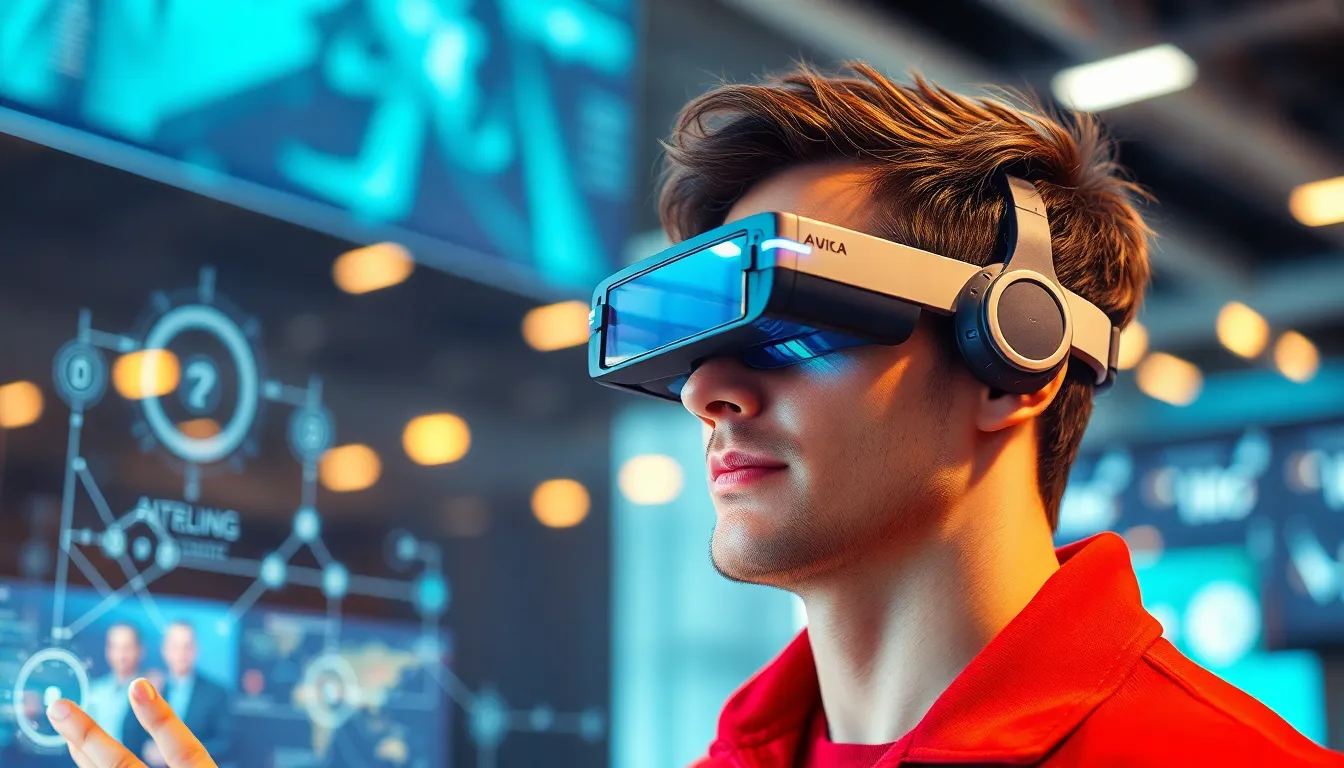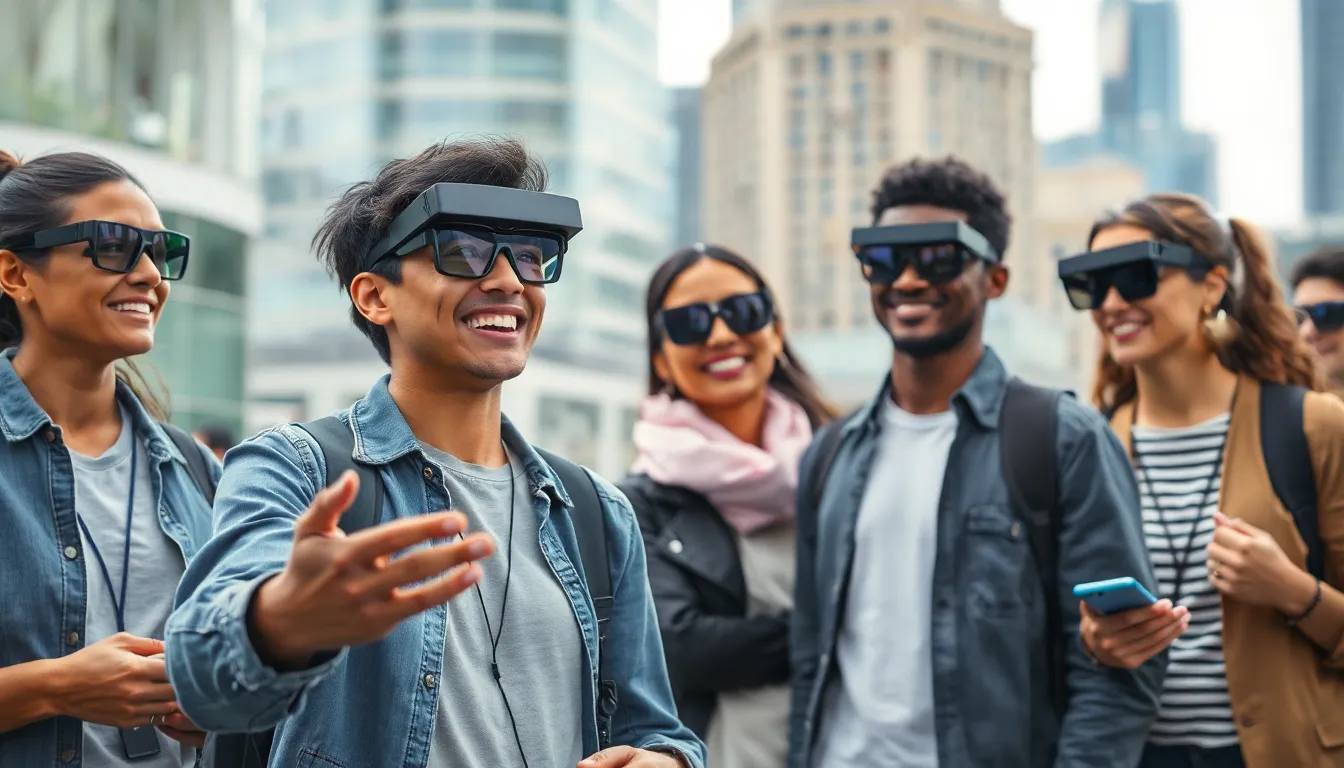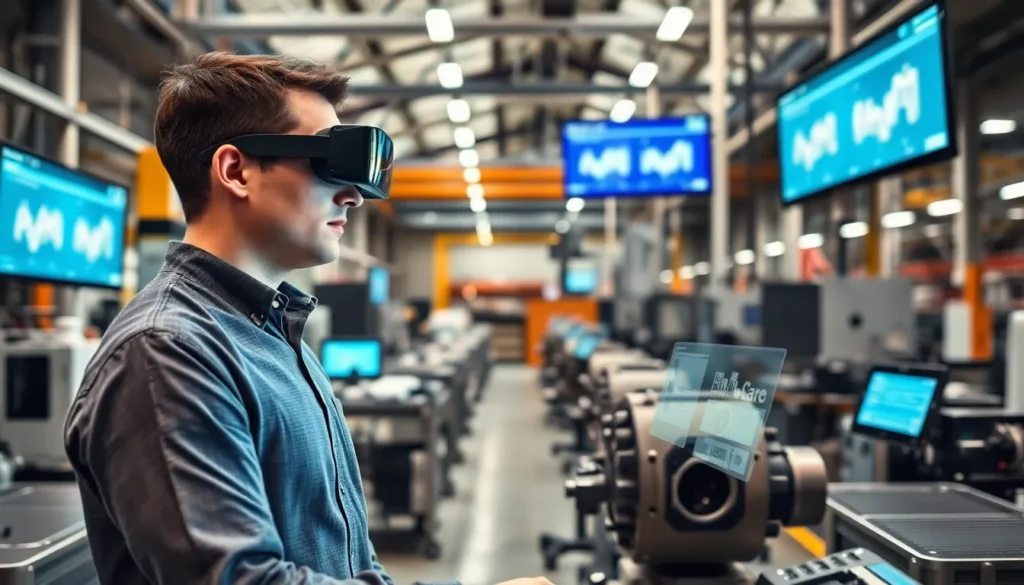Imagine strapping on a pair of glasses that not only help you see the world but also turn it into a digital playground. Welcome to the era of AR wearables, where reality gets a tech-savvy upgrade. These nifty gadgets are more than just a fashion statement; they’re revolutionizing how we interact with our environment, blending the physical and virtual worlds seamlessly.
Table of Contents
ToggleOverview of AR Wearables
AR wearables enhance user interaction with the environment by overlaying digital information onto the physical world. These devices, particularly smart glasses, blend virtual elements seamlessly into daily activities. Users experience various applications, from gaming and education to healthcare and remote collaboration.
Smart glasses represent a significant leap in wearable technology. With features like voice recognition, gesture control, and immersive displays, these devices provide intuitive ways to access information. An example includes Google Glass, which allows users to receive notifications and interact with apps hands-free.
The healthcare sector witnesses substantial AR influence. Surgeons utilize AR wearables for precise guidance during complex procedures, accessing crucial data without diverting attention from the patient. This technology shortens surgical times and improves outcomes.
Education also benefits significantly from AR wearables. Students engage with interactive lessons, enhancing understanding of complex subjects. For instance, AR-enabled glasses facilitate virtual field trips, giving learners the opportunity to explore environments and historical sites from their classrooms.
Moreover, the retail industry employs AR wearables to elevate shopping experiences. Customers try on virtual outfits, visualize products in real time, and receive personalized recommendations. This technology increases engagement and satisfaction.
Finally, AR wearables support remote collaboration. Teams unite regardless of location, sharing data and visualizing projects together. Major companies incorporate AR solutions to improve efficiency, resulting in increased productivity.
AR wearables continue to revolutionize various sectors by merging physical and digital realms effectively. Their growth trajectory indicates a promising future, making them a pivotal part of modern technology.
Key Features of AR Wearables

AR wearables incorporate advanced technologies that significantly enhance user experiences. These features include cutting-edge display technology and various interaction methods.
Display Technology
Display technology in AR wearables includes high-resolution screens and transparent lenses. High-resolution screens deliver vivid imagery that blends seamlessly with the real world. Transparent lenses allow users to view overlaid digital content without obstructing their physical surroundings. Advanced optical systems like micro-displays enhance clarity and reduce distortion. OLED and LCD technologies are commonly used, providing bright colors and deep contrasts that improve visibility in various lighting conditions. Some devices feature holographic displays, creating 3D visuals that enhance immersion.
Interaction Methods
Interaction methods for AR wearables focus on intuitive controls. Voice recognition enables hands-free operation, allowing users to access information through simple commands. Gesture control provides an alternative, permitting users to interact with digital elements by using hand movements. Touch-sensitive interfaces may also be included, letting users tap on surfaces to execute commands. Additionally, eye tracking technology helps devices understand user focus, enabling dynamic content adjustments. These diverse interaction methods contribute to an immersive and user-friendly experience, making AR wearables accessible to a broader audience.
Applications of AR Wearables
AR wearables find diverse applications across various sectors, enhancing user experiences and interactions with their environments.
Gaming and Entertainment
Gaming experiences transform with AR wearables, enabling immersive, interactive play. Players engage with virtual characters and objects integrated into their real-world settings. They explore augmented environments that enhance storytelling and gameplay mechanics. Major game developers, like Niantic, harness AR technology in popular games such as Pokémon GO. In addition, AR wearables facilitate social interactions, allowing friends to share experiences despite physical distances, creating a collaborative gaming atmosphere. The combination of physical movement and digital content promotes deeper engagement, making gaming more interactive than traditional methods.
Healthcare
In healthcare, AR wearables support medical professionals during complex procedures. Surgeons utilize AR glasses to overlay critical information directly onto their field of view, ensuring precision and accuracy. This application reduces risks and enhances surgical outcomes. Moreover, AR wearables assist in medical training by simulating real-life scenarios for students and practitioners. Through virtual anatomy displays, learners gain valuable insights that traditional methods cannot provide. Hospitals increasingly adopt these tools, leading to improved patient care and streamlined workflow in clinical settings.
Education
Education benefits significantly from AR wearables, providing interactive learning experiences for students. Engaging lessons come alive through visual overlays that complement textbook content. Classrooms leverage AR technology for virtual field trips, allowing students to explore historical landmarks or scientific environments without leaving their seats. Teachers can tailor lessons to different learning styles, enhancing comprehension. In addition, universities employ AR wearables for training programs, offering simulations that prepare students for real-world applications. This innovative approach fosters a dynamic educational environment that adapts to students’ needs.
Challenges and Limitations
AR wearables face several challenges and limitations that affect their widespread adoption and functionality.
Technical Limitations
Current AR wearables experience constraints in processing power and battery life. Many devices struggle to balance heavy graphics processing with efficient energy consumption. Limited field-of-view can hinder the immersive experience, as users may only see a fraction of the augmented content. Additionally, compatibility issues arise with existing hardware and software systems, making it challenging for developers to create seamless applications. These technical obstacles hamper the full realization of AR applications across industries, impacting user experiences directly.
User Adoption
User adoption presents a significant challenge for AR wearables. Concerns about privacy and data security can deter potential users. Many individuals remain skeptical about the practicality of these devices in daily life. High costs associated with purchasing AR wearables discourage widespread use, particularly in economically diverse markets. Furthermore, a lack of compelling content fails to engage users and showcase the technology’s potential. As awareness and education about AR wearables continue to grow, user acceptance may gradually improve, but immediate hesitation persists.
Future Trends in AR Wearables
In the coming years, advancements in AR wearables are expected to redefine human interaction with technology. Enhanced display capabilities will likely lead to richer, more immersive experiences. Features such as holographic displays and ultra-high-resolution optics promise to deliver unparalleled clarity and detail in digital overlays.
Development in processing power and battery efficiency is on the horizon. As manufacturers strive for longer-lasting performance, wearables will become increasingly practical for everyday use. Designs prioritizing ergonomic comfort and style will also emerge, appealing to a broader audience.
Machine learning and AI integration are anticipated to play significant roles. Such technologies can personalize user experiences based on behavior and preferences, making AR wearables more intuitive. Contextual awareness will improve, allowing devices to adapt to different environments and user needs seamlessly.
Applications in healthcare are predicted to expand significantly. Surgeons will benefit from real-time data and enhanced visualization during complex operations. Training programs will likely improve, utilizing AR to simulate procedures in high-stakes environments.
Expansion into the retail sector is also noteworthy. Integration with e-commerce platforms will enhance shopping experiences by allowing virtual try-ons for various products. Furthermore, brands could leverage immersive advertising strategies, engaging customers in unique ways.
Concerns regarding privacy and data security are expected to drive innovation in secure AR solutions. Developers will focus on creating transparent policies and technologies ensuring user trust. User education around AR wearables will also grow, facilitating wider acceptance and usage.
Trends suggest a future where AR wearables become ubiquitous. Integration into daily life will transform how individuals interact with their surroundings. Significant investment in AR research and development signals a robust growth trajectory.
AR wearables are set to redefine how individuals interact with their environments. As technology advances these devices will become more integrated into daily life offering enhanced experiences across various sectors. The potential for personalized applications in healthcare retail and education is immense.
While challenges like privacy concerns and technical limitations exist ongoing innovations will likely address these issues. As AR wearables evolve they promise to create a seamless blend of the digital and physical worlds. This transformation will not only enhance user interaction but also pave the way for new possibilities in how people engage with technology. The future of AR wearables looks bright and full of potential.





